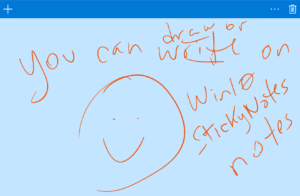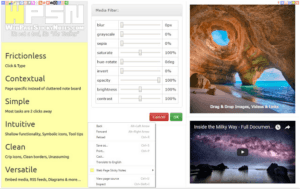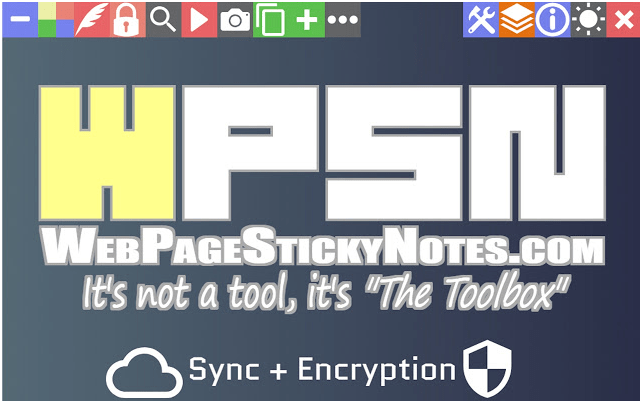Using actual paper sticky notes seldom works well for the multitude of web pages. The reason why is we travel from browser to browser on different devices. In this blog entry, we will explore several solutions to this common problem.
Problem
“How can I put sticky-notes on a webpage I happen to be visiting so I can remember what I need to do with it?”
Sticky notes can be a boon for students capturing notes on a web page, too. Note-taking has several benefits that go beyond interactive checklists. Now that we’ve clarified the problem, let’s see what Chrome browser extensions or apps work.
Solution #1: Sticky Notes – Just Popped Up!
This Chrome browser extension makes adding digital sticky notes easy and quick. You have a variety of color combinations to choose from for your sticky note. Sticky Notes are “always on top,” but you can hide them for a short time. Click on the stylized “n” on a yellow background. Even if you empty the Chrome browser’s cache or cookies, data is not lost. What’s more, all data is auto-saved. That’s a big deal. One feature I wish Sticky Notes had is the ability to move the note around the web page. As of its current release, the note appears in the top right hand corner of the screen. Another feature that it lacks is having more than one note per web page.
A nice alternative to this extension is Note Anywhere. It allows you to move notes around the screen and saves the notes to a web page. It lacks many features other solutions have, but it does offer adding more than one note to a web page. However, you cannot resize the note. Too bad this first solution lacks these features as well.
Solution #2: Sticky Notes
Similar in name the previous solution, this Sticky Notes has a few different features. This Chrome app (as opposed to a browser extension) makes it easy to save notes. It is designed to be used as a desktop computer app. But, since it saves your notes to Google Drive, you could also use it on a Chromebook to keep track of any needed notes. It features a menu that offers speech-to-text, link embedding, and much more, as you can see from the list below. For example, the text showing in the note below was dictated.

Its feature list includes speech recognition for dictation, Google Drive synchronization, and online note sharing. You can move notes around on the screen, pin a note “always on top,” and choose colors and fonts. A feature many Google Keep users wish for is the ability to format text with bold, underline, and italics. This app enjoys all those. It also handles task or to-do lists as well.
Solution #3: Post It All: Sticky Notes
This powerful solution combines many of the features of solutions one and two. You add sticky notes to your favorite web pages and then notes appear across browsers and devices. The multi-colored notes are easy to add to pages you visit or created in a dashboard. A serious drawback to this extension, however, is that it reloads your open browser tabs. It appears to lack a graphical interface to text formatting options. If you know keyboard shortcuts (Ctrl-B for bold), you can take advantage of those features.

Windows 10 Sticky Notes app
Did You Know?
If you are a Windows 10 user, there is a built-in “Sticky Notes” app. Launch the Win10 Sticky Notes app via Cortana in the bottom left corner of your screen. Look for a space to type or magnifying glass. You can also find it listed under “S” in the Start Menu list of programs. Type Ctrl-N to create a new note or Ctrl-D to delete it. Learn more.
Solution #4: Notematic or Note Board
Need more complex solutions? While these are outside the scope of this blog entry, here are two. The first is Notematic.
A bit more complex at first, Notematic comes with a tutorial. To create notes, you long-press with your left mouse button to create a note. The note allows you to specify a title and then fill in your notes. You can create pin boards to house your non-website attached notes. I do not recommend it for use with younger learners. Older students may find its feature set rich and worthy of exploration. One caveat: To synchronize your notes, you will have to create a Notematic Cloud account. This may be undesirable in a K-12 environment.
A similar, more robust solution is available for Android and iOS apps. Try the cross-platform, cross-browser Note Board. Again, you will need to make an account. Consider Google Keep and/or OneNote as free alternatives to these two options.
Solution #5: Notes for Google Drive
A nifty note-taking solution, this Chrome extension saves your notes to Google Drive. You can open the notes as Google Docs. Some features that set it ahead of the others include bold, italics, and text highlighting, and the ability to add bulleted or numbered lists. This particular extension works independent of a web page, so no assigning notes to a set page. The fixed position of the notes make it less than desirable. The inability to adjust the note window size can cover up valuable screen space. This can block critical content.
What Do You Recommend?
Finding the right digital sticky note solution can be tough. After looking over so many note-taking apps, I have two recommendations. Need to keep it simple? Use Solution #1. It makes adding a single note to a page easy.

Need something a bit more full-featured? Use Web Page Sticky Notes. This is a Chrome extension that allows many, movable digital sticky notes. Web Page Sticky Notes gives power users encryption options for security. You can export/import notes and use Markdown and many more options.
Not sure you like these choices? Spend a few hours exploring the Chrome Web Store “notes” options.

